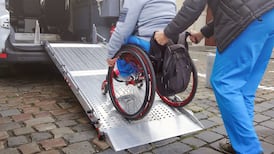Someday soon, perhaps within a year, you’ll be able to slap a soft, stretchy patch on to your arm that tells you if you’re dehydrated. Or that your electrolytes are dangerously out of balance. Or even that you have diabetes.
Fitness trackers such as Fitbit and Apple Watch already track step counts, heart rate and sleep rhythms. But they tend to be rigid and bulky, and mostly gather mechanical metrics, rather than assess a person's underlying biology.
A new generation of devices instead aim to analyse sweat for many chemicals at once, producing a real-time snapshot of the wearer's health or fitness. These devices also fit intimately against the skin, and are comfortable for anyone, from premature babies to the elderly. One version is already being advertised by Gatorade.
It fits into a broader trend that you're seeing in medicine, which is personalised, tailored approaches to treatment and delivery of care
The latest advance in this technology, described in the journal Science Advances, provides real-time information on the wearer's pH, sweat rate, and levels of chloride, glucose and lactate – high levels of which could signal cystic fibrosis, diabetes or a lack of oxygen.
"It fits into a broader trend that you're seeing in medicine, which is personalised, tailored approaches to treatment and delivery of care," says John Rogers, a biomedical engineer at Northwestern University in Illinois and the key architect of the device.
Technology like this has been anticipated for years, but the field has accelerated rapidly. Some similar devices in development are soft. Some use electric sensors to read chemicals. Others rely on colorimetrics, in which the intensity of the colour in the readout matches the concentration of the chemical being monitored. The new device delivers all of that in a battery-free and wireless form.
"This looks like the first version in which they integrated all of it in one device," says Martin Kaltenbrunner, an engineering professor at Joannes Kepler University Linz, in Austria, who was not involved in the research. "The level of technology that is in this paper is very, very advanced."
The new device has minuscule holes at its base into which sweat naturally flows. From there, a complex network of valves and microchannels, each roughly the width of a human hair, route the sweat into tiny reservoirs. Each reservoir contains a sensor that reacts with a chemical in the sweat, such as glucose or lactate. “That’s basically it,” Rogers says. “There’s nothing that penetrates the skin, and there’s no power supply that’s driving flow.”
The device relies on the same technology that smartphones use to send wireless payments; the phone can both deliver power through this wireless coupling, and receive data back. Alternatively, the data could be sent to a reader attached to a treadmill or elsewhere in a fitness room – and, perhaps eventually, to a reader much farther away.
The system is versatile and could be set up to track the same chemical, or several, over time, such as the level of lactate in a runner as a marathon progresses. Because the device is waterproof and modelled to the body, it also could be used by swimmers to track their performance.
Eventually, the device would fill up with sweat – not so hygienic – but the channel system can be easily separated from the electronics and swapped out, giving the device a longer life span. “This approach is especially nice, this modular construction of sensors,” Kaltenbrunner says.
To be marketed at large scale, any sweat-based sensor would need to be manufactured at a low cost. Many teams are focused on this goal because of the potential of the devices to transform healthcare, Kaltenbrunner says. “If I have to go to the clinic once a day to have my data collected, I wouldn’t really do it,” he says. “But it just means wearing a patch and being able to self-monitor myself, then eventually this barrier will be reduced.”
Rogers’ team has begun testing the technology as a way to screen for cystic fibrosis, a rare genetic condition. Doctors already look at chloride concentrations in sweat to identify children with the condition, but they typically use a rigid, uncomfortable device that straps tightly on to the child’s arm for a one-time measurement.
In 2017, another team described a flexible, wearable sensor that also analyses chloride in sweat to screen for cystic fibrosis. But that sensor is battery-powered, and does not capture separate volumes of sweat as Rogers’ device does.
The device is really important because it is comfortable to wear, has different sensing modalities and is robust
"Really what is needed is big data for human health," says Ali Javey, a member of the team that proposed the earlier sensor and a professor of electrical engineering and computer science at the University of California, Berkeley. The device invented by Rogers "is really important", according to Javey, because it is "comfortable to wear, has different sensing modalities and is robust".
Rogers' team has been testing their device with children who have cystic fibrosis at Lurie Children's Hospital of Chicago. It is in the late stages of a clinical trial, and plans to apply for approval from the US Food and Drug Administration (FDA).
A much bigger market for sensors lies in helping people with diabetes track their glucose levels. The most advanced diabetes sensor, approved in 2017, is a soft skin patch coupled to a small reader, and relies on tiny needles that pierce the skin to monitor blood glucose.
The ideal device would not involve needles or draw blood. To use sweat instead, however, scientists first need to learn more about it – how sweat rates vary among individuals, how different biochemicals make their way into sweat, and how well those levels reflect blood glucose. "We need to take a step back and be careful to think about how we can make sense of what we're measuring," says Carlos Milla, Javey's collaborator and a professor of paediatrics at Stanford University.
The new study underscores Milla’s concern. The device measured glucose in sweat, but the results suggested that this was not a good proxy for glucose in the blood. The sweat glucose levels reflect blood glucose from 30 to 60 minutes earlier, too long of a delay to help people with diabetes. “It’s indicating this might not be as simple as one might have initially hoped,” Rogers says. He adds that sweat glucose might be more helpful as a metric in screening for diabetes rather than for real-time monitoring of glucose levels.– New York Times

Sign up for one of The Irish Times' Get Running programmes (it is free!).
First, pick the eight-week programme that suits you.
- Beginner Course: A course to take you from inactivity to running for 30 minutes.
- Stay On Track: For those who can squeeze in a run a few times a week.
- 10km Course: Designed for those who want to move up to the 10km mark.
Best of luck!










